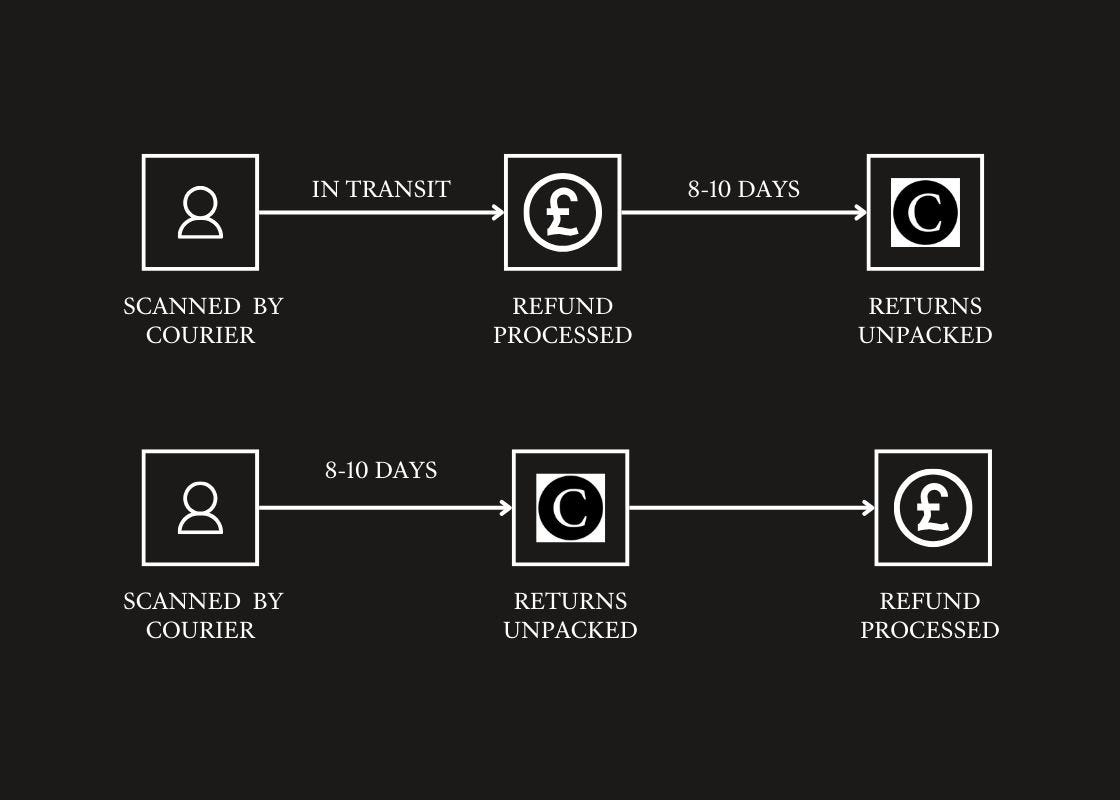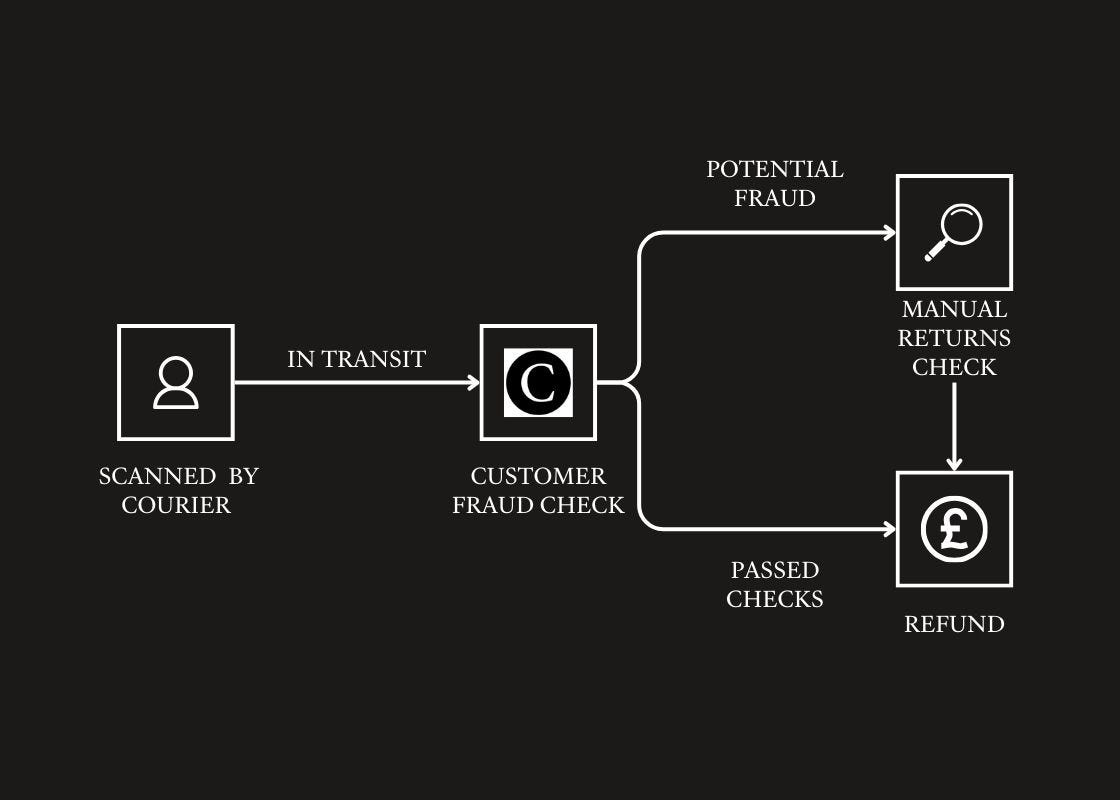How to Stop Returns Fraud
The Hidden Cost of Online Shopping
Returns fraud isn’t a topic that gets much airtime, but for brands handling high volumes of online sales, it’s a growing and costly issue. In fact, in 2023, return fraud accounted for a staggering $101 billion in total losses for retailers. This equates to retailers losing approximately $13.70 for every $100 worth of returned merchandise — and this doesn’t account for unfavourable returns behaviours, like ordering multiple items for “fit” just to return them.
The ease of online shopping has fuelled the expectation of fast, frictionless returns, but with that comes an opportunity for exploitation.
We’ve worked with some of the fastest-growing brands, and we’ve seen how fraudsters can manipulate well-meaning returns processes. It starts small—a wrong item here, a damaged product there—but when fraud becomes systematic, it can seriously undermine profitability.
While many retailers focus on speeding up returns for genuine customers, they also have to consider how criminals might be gaming the system. So, how do you balance the need for a seamless customer experience with safeguarding your business from fraudulent returns?
Caveat: In this article we’re going to be cover returns fraud, not policy abuse. We’ve covered that in this article:
Repeat Returns Offenders
At Commerce Thinking, we’ve helped some of the biggest brands create returns strategies that work, and we understand this problem better than anyone. Serial returners—those customers who repeatedly buy and return items—pose a growing challenge for many retailers. While returns are an accepted part of retail, particularly in fashion, dealing with habitua…
How Returns Fraud Happens
When you’re processing thousands of returns, it’s easy for fraudulent behaviour to slip through the cracks. The issue becomes even more pronounced when automation is introduced to streamline the returns experience. Automation is key to maintaining customer satisfaction, but it can also create loopholes.
Consider this typical returns process:
The customer prints the return label.
The parcel is dropped off, and the courier scans the label to signal the return is in transit.
The package arrives at the retailer's warehouse and is unpacked and inspected.
The tricky part is that many brands trigger refunds as soon as the return enters the courier network, rather than waiting for the item to be received and inspected. While this shaves days off the refund process and keeps customers happy, it also creates an opportunity for fraud. Criminals have figured out that they can send back a box full of worthless items—sometimes just rocks or other heavy objects—knowing they’ll be refunded before the retailer ever realises what’s inside. By the time the fraud is discovered, they’ve already pocketed their refund and disappeared.

The Risks of Automation in Returns
We’ve seen this play out with brands that implemented automated returns to improve the customer experience. A digitally native apparel company we worked with began offering instant refunds upon the return entering the courier network, which shaved off a significant portion of the return processing time. Initially, this seemed like a win-win—customers received refunds faster, and the brand benefited from happier buyers.
But it wasn’t long before the cracks began to show. Organised groups exploited this automation, sending back items that weren’t what they claimed. For this retailer, a small percentage of returns turned out to be fraudulent, costing them far more than they expected. As a result, they adapted their strategy, limiting instant refunds to international customers where the return shipping time was long enough to justify the risk.
For many brands, the challenge is balancing this kind of efficiency with the potential for abuse. Automation can save time and resources, but it requires careful oversight to avoid creating opportunities for fraud.
Most 3rd party returns management systems offer some element of automation to flag high risk merchants allowing for manual intervention before a refund is then processed.

Maintaining revenue in the business is of highest importance when it comes to returns where exchanges and gift cards are key drivers for that. A gift card as a refund performs best when you add extra value to it - here it's important you've got process and automation in place that only grants this giftcard, with added value, once.
There are many retailers that want to be able to offer instant exchanges and refunds, however here there's a big fraud risk. When you're customer is showing a responsible returns behaviour, i.e. is a good and profitable customer, grant instant exchanges and refunds for them as a loyalty perk where a new customer may have to wait for their exchange or refund to be processed when the warehouse have inspected the items.
It should also be easy for the customer to report a claim or faulty item, if this genuinely is the case. Ingrid's return platform offer this feature where the warehouse can also inspect the photo of the item before they process the return label, in case the complaint' is not valid.
Elin Hammenfors, Head of UK Sales - Ingrid
Third-Party Logistics: The Bottleneck
When brands outsource their returns processing to third-party logistics (3PL) providers, another layer of complexity is added. While 3PLs handle the operational side, they often struggle with capacity, particularly during peak seasons. We’ve worked with premium lifestyle brands where returns are processed through a 3PL, and the delays this creates can frustrate customers.
For example, a client of ours partnered with a 3PL to manage its returns, but the provider’s low capacity meant it took up to 10 days for returns to be unpacked and processed (in addition to the transit time!). During this time, customers were left waiting for their refunds, unaware that the delay wasn’t the brand’s fault. As negative reviews poured in, customers began to believe the brand was deliberately withholding their money, further damaging its reputation.
The knock-on effect of slow processing times is clear: frustrated customers, increased pressure on customer support, and potential reputational harm.
Using Data to Combat Returns Fraud
To tackle returns fraud, brands need to leverage the data at their disposal. Modern returns management systems allow retailers to track customer behaviour, identify patterns of abuse, and take action before fraud becomes a bigger issue.
By tagging high-risk customers—those with a history of suspicious returns—brands can implement more stringent returns policies. This might involve withholding refunds until the item has been fully inspected, or requiring high-risk customers to follow a more manual returns process.
We’ve seen brands use this approach effectively by combining it with incentive-based solutions. For instance, offering customers gift cards instead of refunds can protect revenue while still providing a positive customer experience. Gift cards can be issued as soon as the return enters the courier network, reducing the chance of fraud, and they’re particularly useful for size exchanges where speed is essential.
Outsourcing Returns to Specialists
Another solution lies in working with specialists who focus solely on returns. Some third-party providers, like Rebound, offer returns services where all returned items are unpacked and inspected before being sent back to the brand in bulk. This reduces the likelihood of fraudulent items making it back into circulation, and it’s particularly useful for brands dealing with overseas returns, where shipping costs are higher.
For example, a sustainable fashion label we worked with employed a service like this in the US market, consolidating returns into bulk shipments rather than handling individual packages. This not only saved them money on shipping but also allowed for more thorough inspection of returned items.
However, it’s important to note that even these services can face bottlenecks during peak sales periods like Black Friday, when returns volumes skyrocket. The key is ensuring that these providers have the capacity to manage returns efficiently, without creating delays that impact the customer experience.
Conclusion: A Smarter Approach to Returns Fraud
Returns fraud is a complex issue, but it’s one that can be managed with the right strategy. By combining automation with careful oversight, leveraging data to flag suspicious behaviour, and working with specialised providers, brands can protect themselves from fraudulent activity without compromising on customer satisfaction.
And it’s important to remember that policy abuse among shoppers is often well intentioned - most shoppers say they commit fraud and/or abuse for mostly innocent reasons, while retailers assume the top reasons are more negative.
“With returns fraud it’s important to remember that the customer isn’t the enemy. Rather, shoppers - and retailers - benefit from increased education and clearer guardrails to encourage compliance within return policies.”
John-David Klausner, SVP, Partnerships at Loop
At Commerce Thinking, we’ve helped some of the biggest brands refine their returns strategies to combat fraud while maintaining the high level of service that customers expect. Whether you’re looking to automate returns, streamline logistics, or tackle fraud head-on, we’ve got the expertise to help you find the right balance.
Is returns fraud eating into your profits? At Commerce Thinking, we specialise in building tailored returns strategies that protect your business from fraud while keeping customers happy. Contact us today to learn how we can help optimise your returns process and safeguard your revenue.



